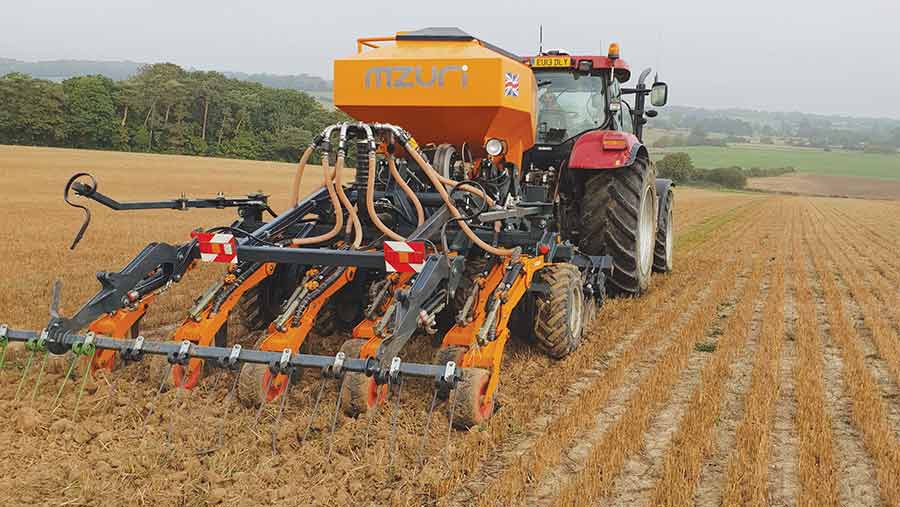Direct drills revisited: Mzuri Pro-Til 3T out, Avatar in
The transition from multi-pass cultivations to a no-till system is all but complete at Gillshaw Farm, the final piece of the puzzle coming last summer with the switch from a 3m Mzuri Pro-Til to a 6m Horsch Avatar.
With once-rampant blackgrass now largely under control through a combination of minimal soil disturbance and advanced chemistry, farmer Matt Lewis reckons the change was a punt worth taking.
See also: Driver’s view: Matt Lewis’ Mzuri Pro-Til 3m drill
“The Mzuri was our first move away from a maximum-tillage system with a cultivation train and Vaderstad Rapid, and it was driven purely by blackgrass pressure. Switching to the Avatar has taken that one stage further.

Matt Lewis © MAG/Oliver Mark
Mzuri Pro-til 3T (2016) specs
- Width/spacing 3m/330mm
- Coulters Nine tines
- Hopper 1,800 litres
- Price paid £35,000
Horsch Avatar 6.16 SD (2022) specs
- Width/spacing 6m/167mm
- Coulters/pressure 36 discs/250kg
- Hopper 5,000-litre triple tank, plus Duo Drill hopper on the rear
- Price paid £102,000
“Initially, going for the Pro-Til allowed us to eliminate cultivations, so I could be a bit bolder in pushing back the drilling date because the ground stayed workable for that bit longer.
“Plus, the Mzuri performed reasonably well even if the weather started to deteriorate, as the duck-foot tine loosened soil below the seed to provide decent drainage and encourage quick germination.
“As a side benefit, it also reduced our establishment costs.”
The 3m trailed Mzuri Pro-Til arrived in 2016 and, says Matt, was the perfect halfway house to a potentially zero-till system.
“It was great in many ways – it was simple to calibrate, the legs were easy to change, and the wearing metal lasted well.”
“Though wheat yields with the Mzuri couldn’t match those of the Vaderstad Rapid in a good year, it was a far cheaper means of establishment.”
But depth control wasn’t entirely consistent and, with the tines moving most of the ground, the fields often looked like they’d been cultivated.
This meant making another pass at 45deg to the drill with a set of rolls to iron out the strip-till corrugation effect and maximise the efficacy of pre-emergence sprays.
The Pro-Til was also subject to a few tweaks during its six-year stay, including fitting isobus controls and upgrading the 6in-wide ribbed press wheels to ones with a curved profile that were less prone to blocking in the wet.

Mzuri Pro-Til – the perfect halfway house to a no-till system, says Matt Lewis © Matt Lewis
Avatar arrival
The lure of a farm equipment grant, combined with the prospect of eliminating soil disturbance, were enough to convince Matt to make the switch to a Horsch Avatar.
Prior to that, Weaving’s GD and the Sky EasyDrill both arrived for on-farm demos, but neither impressed with the ability to reliably penetrate hard ground.
The Cross Slot was deemed too expensive and there was no local dealer for Novag’s T-Force.
Matt also checked out a neighbour’s Amazone Cayena, but concluded that it was more akin to a chisel cultivator. That left the John Deere 750A and Horsch Avatar.
“I know people with the 750A, and I know it’s a system that works. But it still has the Accord metering system – the Horsch setup is far superior and I already get great service from the local dealer, Manns at Headcorn.”
It has proved a tough year to make a dramatic change, with yields down on the average.
“It’s been the worst season for a such a major transition, so results are hard to assess, but the farm is the cleanest it has been for eight years.
“It’s difficult to know how much of that is down to the drill minimising surface disturbance and how much can be credited to using Luximo [cinmethylin] pre-em chemistry to get on top of grassweeds.”
Doubling the working width to 6m has also been transformative.
With a modest 300ha of arable land to cover on the home farm, plus casual contracting that typically amounts to 100ha, it has given him more time to manage the farm’s 120-strong Sussex suckler herd.
“Timeliness is key with this system, so the fact that I can get the cereals drilled in five days allows me to be picky about when I run it.
“It also means there’s no need to roar through – I can cruise at 8-10kph and ensure the press wheels do what they need to.”
“I’ve learned that if the conditions aren’t right, there’s simply no point trying. It’ll end up forming a smeared slot with no drainage, and there’s a good chance the seeds will just rot.”
Easy pulling
Another benefit of the Avatar is that it’s far easier to pull than the Mzuri, with fuel consumption on the Fendt 724 having dropped from 45 litres/hour to the mid-20s.
“The downside is that the wheels are at the back and it turns like a boat. The visibility isn’t great on the road either, so I’ve mounted a rear-facing camera just for getting through town.
“The other challenge is filling it. The drill needs to be fully unfolded to access the gantry; it would be nice to isolate one wing so I can get to the hoppers on the side folded down and approach with the telehandler from the other.”
Extra hopper
For maximum versatility, Matt bought a second-hand Duo Drill that is mounted on a custom platform at the back. This allows him to apply Avadex at the time of drilling, saving another pass.
He also tweaked the configuration of the two distribution towers so they feed the front and rear rows of coulters, rather than the left and right sides.
This setup, combined with the drill’s triple tank configuration, means he can sow oilseed rape with the front coulters, lay fertiliser, and put buckwheat through the second bank. This then dies off in the frost, leaving wider rapeseed rows.
At the same time, slug pellets can be applied from the Duo Drill via a home-built distribution bar.
For winter wheat, this arrangement has been exploited to reduce disease problems in KWS variety Zyatt by inter-row sowing Crusoe – something that appears to have been successful.
Reduced costs
The transition has more than halved the farm’s establishment costs from £160/ha with the heavy cultivation system – when diesel costs were low – to just £60/ha.
That rises to £75/ha when a pass with the rolls is factored in, something Matt is still keen on to manage slug pressure.
Going forward, the plan is to integrate a degree of tillage that will include an Opico cultivator equipped with Stealth low-disturbance legs on a three- or four-year rotation and possibly a shallow pass with a Vaderstad Crosscutter.
This will encourage a grassweed chit, reduce the slug burden and speed up the breakdown of the previous year’s crop.
Mzuri Pro-til 3T (2016) likes and gripes
Likes
- Fairly versatile
- Good stepping stone to no-till
- Tine loosens ground below seed
- Simple calibration
Gripes
- Too much cultivated ground
- Original press wheels bunged up
- Left a corrugated surface that required rolling
- Horsepower hungry
Horsch Avatar 6.16 SD (2022) likes and gripes
Likes
- Good disc penetration
- Accurate metering system
- Low power requirement
- Minimal disturbance
Gripes
- Turns like a boat
- Poor visibility on the road
- Potentially hard to fill hoppers
- Not as versatile as a tine drill

